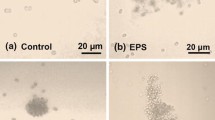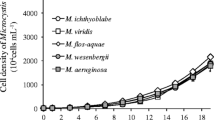Abstract
Colony formation of cyanobacteria is crucial for the formation of surface blooms in lakes. However, the underlying mechanisms of colony formation involving in physiological and cell surface characteristics remain to not well be established. Six cyanobacterial Microcystis strains (including both unicellular and colonial ones) were employed to estimate the influences of their physiological traits and the composition of extracellular polymeric substances (EPS) on colony or aggregate formation. Results show that raising the number of the photosynthetic reaction center and light-harvesting antenna in the PSII and reducing the growth rate were the major physiological strategies of Microcystis to produce excess EPS enhancing colony formation. Tightly bound EPS (T-EPS) was responsible for colony formation, which approximately accounted for 50% of the total amount of EPS. Five fluorescent components (protein-, tryptophan-, and tyrosine-like components and two humic-like components) were found in the T-EPS, although the amounts of these components varied with strains. Importantly, colonial strains contained much higher tyrosine-like substances than unicellular ones. We suggest that tyrosine-like substances might serve as a crosslinking agent to connect other polymers in EPS (e.g., proteins or polysaccharides) for colony formation. Our findings identified key physiological traits and chemical components of EPS for colony formation in Microcystis, which can contribute to a better understanding on the formation of Microcystis blooms.
Similar content being viewed by others
Data Availability Statement
The datasets generated during and/or analyzed during this study are available from the corresponding author on reasonable request.
References
Bahram M, Bro R, Stedmon C et al. 2006. Handling of Rayleigh and Raman scatter for PARAFAC modeling of fluorescence data using interpolation. Journal of Chemometrics, 20(3–4): 99–105, https://doi.org/10.1002/cem.978.
Bradford M M. 1976. A rapid and sensitive method for the quantitation of microgram quantities of protein utilizing the principle of protein-dye binding. Analytical Biochemistry, 72(1–2): 248–254, https://doi.org/10.1016/0003-2697(76)90527-3.
Chen W, Westerhoff P, Leenheer J A et al. 2003. Fluorescence excitation-emission matrix regional integration to quantify spectra for dissolved organic matter. Environmental Science & Technology, 37(24): 5701–5710, https://doi.org/10.1021/es034354c.
Duan Z P, Tan X, Li N G. 2017. Ultrasonic selectivity on depressing photosynthesis of cyanobacteria and green algae probed by chlorophyll-a fluorescence transient. Water Science & Technology, 76(8): 2085–2094, https://doi.org/10.2166/wst.2017.376.
Duan Z P, Tan X, Paerl H W et al. 2021. Ecological stoichiometry of functional traits in a colonial harmful cyanobacterium. Limnology and Oceanography, 66(5): 2051–2062, https://doi.org/10.1002/lno.11744.
Duan Z P, Tan X, Parajuli K et al. 2018. Colony formation in two Microcystis morphotypes: effects of temperature and nutrient availability. Harmful Algae, 72: 14–24, https://doi.org/10.1016/j.hal.2017.12.006.
Duan Z P, Tan X, Parajuli K et al. 2019. Characterization of Microcystis morphotypes: implications for colony formation and intraspecific variation. Harmful Algae, 90: 101701, https://doi.org/10.1016/j.hal.2019.101701.
Duan Z P, Tan X, Zhang D F et al. 2020. Development of thermal treatment for the extraction of extracellular polymeric substances from Microcystis: evaluating extraction efficiency and cell integrity. Algal Research, 48: 101879, https://doi.org/10.1016/j.algal.2020.101879.
Forni C, Telo’ F R, Caiola M G. 1997. Comparative analysis of the polysaccharides produced by different species of Microcystis (Chroococcales, Cyanophyta). Phycologia, 36(3): 181–185, https://doi.org/10.2216/i0031-8884-36-3-181.1.
Gerphagnon M, Macarthur D J, Latour D et al. 2015. Microbial players involved in the decline of filamentous and colonial cyanobacterial blooms with a focus on fungal parasitism. Environmental Microbiology, 17(8): 2573–2587, https://doi.org/10.1111/1462-2920.12860.
Glazer A N. 1984. Phycobilisome a macromolecular complex optimized for light energy transfer. Biochimica et Biophysica Acta (BBA) — Reviews on Bioenergetics, 768(1): 29–51, https://doi.org/10.1016/0304-4173(84)90006-5.
Griffiths P R, de Haseth J A. 2006. Fourier Transform Infrared Spectrometry. 2th ed. John Wiley & Sons, Inc., Hoboken, New Jersey.
Grossman A R, Schaefer M R, Chiang G G et al. 1993. The phycobilisome, a light-harvesting complex responsive to environmental conditions. Microbiological Reviews, 57(3): 725–749.
Harke M J, Steffen M M, Gobler C J et al. 2016. A review of the global ecology, genomics, and biogeography of the toxic cyanobacterium, Microcystis spp. Harmful Algae, 54: 4–20, https://doi.org/10.1016/j.hal.2015.12.007.
Helm R F, Potts M. 2012. Extracellular matrix (ECM). In. Whitton B A ed. Ecology of Cyanobacteria II: Their Diversity in Space and Time. Springer, Dordrecht. p.461–480, https://doi.org/10.1007/978-94-007-3855-3_18.
Li M, Zhu W, Gao L et al. 2013. Changes in extracellular polysaccharide content and morphology of Microcystis aeruginosa at different specific growth rates. Journal of Applied Phycology, 25(4): 1023–1030, https://doi.org/10.1007/s10811-012-9937-7.
Li M, Zhu W, Gao L. 2014. Analysis of cell concentration, volume concentration, and colony size of Microcystis via laser particle analyzer. Environmental Management, 53(5): 947–958, https://doi.org/10.1007/s00267-014-0252-8.
Liu L Z, Qin B Q, Zhang Y L et al. 2014. Extraction and characterization of bound extracellular polymeric substances from cultured pure cyanobacterium (Microcystis wesenbergii). Journal of Environmental Sciences, 26(8): 1725–1732, https://doi.org/10.1016/j.jes.2014.06.013.
Murphy K R, Butler K D, Spencer R G M et al. 2010. Measurement of dissolved organic matter fluorescence in aquatic environments: an interlaboratory comparison. Environmental Science & Technology, 44(24): 9405–9412, https://doi.org/10.1021/es102362t.
Murphy K R, Stedmon C A, Wenig P et al. 2014. OpenFluor — an online spectral library of auto-fluorescence by organic compounds in the environment. Analytical Methods, 6(3): 658–661, https://doi.org/10.1039/C3AY41935E.
Myklestad S M. 1995. Release of extracellular products by phytoplankton with special emphasis on polysaccharides. Science of The Total Environment, 165(1–3): 155–164, https://doi.org/10.1016/0048-9697(95)04549-G.
Nakamoto K. 2009. Infrared and Raman Spectra of Inorganic and Coordination Compounds: Part B: Applications in Coordination, Organometallic, and Bioinorganic Chemistry. 6th ed. John Wiley & Sons, Inc., Hoboken. 416p.
Partlow B P, Applegate M B, Omenetto F G et al. 2016. Dityrosine cross-linking in designing biomaterials. ACS Biomaterials Science & Engineering, 2(12): 2108–2121, https://doi.org/10.1021/acsbiomaterials.6b00454.
Pereira S, Zille A, Micheletti E et al. 2009. Complexity of cyanobacterial exopolysaccharides: composition, structures, inducing factors and putative genes involved in their biosynthesis and assembly. FEMS Microbiology Reviews, 33(5): 917–941, https://doi.org/10.1111/j.1574-6976.2009.00183.x.
Shen H, Song L R. 2007. Comparative studies on physiological responses to phosphorus in two phenotypes of bloom-forming Microcystis. Hydrobiologia, 592(1): 475–486.
Sheng G P, Yu H Q, Li X Y. 2010. Extracellular polymeric substances (EPS) of microbial aggregates in biological wastewater treatment systems: a review. Biotechnology Advances, 28(6): 882–894, https://doi.org/10.1016/j.biotechadv.2010.08.001.
Sofia S J, Singh A, Kaplan D L. 2002. Peroxidase-catalyzed crosslinking of functionalized polyaspartic acid polymers. Journal of Macromolecular Science, Part A, 39(10): 1151–1181, https://doi.org/10.1081/MA-120014843.
Stal L J. 2017. Gregarious cyanobacteria. Environmental Microbiology, 19(6): 2105–2109, https://doi.org/10.1111/1462-2920.13739.
Stanier R Y, Kunisawa R, Mandel M et al. 1971. Purification and properties of unicellular blue-green algae (Order Chroococcales). Bacteriological Reviews, 35(2): 171–205, https://doi.org/10.1128/br.35.2.171-205.1971.
Stedmon C A, Bro R. 2008. Characterizing dissolved organic matter fluorescence with parallel factor analysis: a tutorial. Limnology and Oceanography: Methods, 6(11): 572–579, https://doi.org/10.4319/lom.2008.6.572.
Stedmon C A, Markager S. 2005. Tracing the production and degradation of autochthonous fractions of dissolved organic matter by fluorescence analysis. Limnology and Oceanography, 50(5): 1415–1426, https://doi.org/10.4319/lo.2005.50.5.1415.
Sukenik A, Kaplan A. 2021. Cyanobacterial harmful algal blooms in aquatic ecosystems: a comprehensive outlook on current and emerging mitigation and control approaches. Microorganisms, 9(7): 1472, https://doi.org/10.3390/microorganisms9071472.
Wang B B, Liu X T, Chen J M et al. 2018. Composition and functional group characterization of extracellular polymeric substances (EPS) in activated sludge: the impacts of polymerization degree of proteinaceous substrates. Water Research, 129: 133–142, https://doi.org/10.1016/j.watres.2017.11.008.
Wilson A E, Kaul R B, Sarnelle O. 2010. Growth rate consequences of coloniality in a harmful phytoplankter. PLoS One, 5(1): e8679, https://doi.org/10.1371/journal.pone.0008679.
Wilson A E, Wilson W A, Hay M E. 2006. Intraspecific variation in growth and morphology of the bloom-forming cyanobacterium Microcystis aeruginosa. Applied and Environmental Microbiology, 72(11): 7386–7389, https://doi.org/10.1128/AEM.00834-06.
Wu Z X, Song L R. 2008. Physiological comparison between colonial and unicellular forms of Microcystis aeruginosa Kütz. (Cyanobacteria). Phycologia, 47(1): 98–104.
Xiao M, Li M, Duan P F et al. 2019. Insights into the relationship between colony formation and extracellular polymeric substances (EPS) composition of the cyanobacterium Microcystis spp. Harmful Algae, 83: 34–41, https://doi.org/10.1016/j.hal.2019.02.006.
Xiao M, Li M, Reynolds C S. 2018. Colony formation in the cyanobacterium Microcystis. Biological Reviews, 93(3): 1399–1420, https://doi.org/10.1111/brv.12401.
Xu F, Zhu W, Xiao M et al. 2016a. Interspecific variation in extracellular polysaccharide content and colony formation of Microcystis spp. cultured under different light intensities and temperatures. Journal of Applied Phycology, 28(3): 1533–1541, https://doi.org/10.1007/s10811-015-0707-1.
Xu H C, Cai H Y, Yu G H et al. 2013a. Insights into extracellular polymeric substances of cyanobacterium Microcystis aeruginosa using fractionation procedure and parallel factor analysis. Water Research, 47(6): 2005–2014, https://doi.org/10.1016/j.watres.2013.01.019.
Xu H C, Jiang H L, Yu G H et al. 2014. Towards understanding the role of extracellular polymeric substances in cyanobacterial Microcystis aggregation and mucilaginous bloom formation. Chemosphere, 117: 815–822, https://doi.org/10.1016/j.chemosphere.2014.10.061.
Xu H C, Lv H, Liu X et al. 2016b. Electrolyte cations binding with extracellular polymeric substances enhanced Microcystis aggregation: implication for Microcystis bloom formation in eutrophic freshwater lakes. Environmental Science & Technology, 50(17): 9034–9043, https://doi.org/10.1021/acs.est.6b00129.
Xu H C, Yan Z S, Cai H Y et al. 2013b. Heterogeneity in metal binding by individual fluorescent components in a eutrophic algae-rich lake. Ecotoxicology and Environmental Safety, 98: 266–272, https://doi.org/10.1016/j.ecoenv.2013.09.008.
Xu H C, Yu G H, Jiang H L. 2013c. Investigation on extracellular polymeric substances from mucilaginous cyanobacterial blooms in eutrophic freshwater lakes. Chemosphere, 93(1): 75–81, https://doi.org/10.1016/j.chemosphere.2013.04.077.
Xu H, Paerl H W, Qin B Q et al. 2010. Nitrogen and phosphorus inputs control phytoplankton growth in eutrophic Lake Taihu, China. Limnology and Oceanography, 55(1): 420–432, https://doi.org/10.4319/lo.2010.55.1.0420.
Xu Y, Lu Y Q, Dai X H et al. 2017. The influence of organic-binding metals on the biogas conversion of sewage sludge. Water Research, 126: 329–341, https://doi.org/10.1016/j.watres.2017.09.046.
Yang Z, Kong F X, Shi X L et al. 2008. Changes in the morphology and polysaccharide content of Microcystis aeruginosa (cyanobacteria) during flagellate grazing. Journal of Phycology, 44(3): 716–720, https://doi.org/10.1111/j.1529-8817.2008.00502.x.
Zhang M, Kong F X, Tan X et al. 2007. Biochemical, morphological, and genetic variations in Microcystis aeruginosa due to colony disaggregation. World Journal of Microbiology and Biotechnology, 23(5): 663–670, https://doi.org/10.1007/s11274-006-9280-8.
Zhang M, Shi X L, Yu Y et al. 2011. The acclimative changes in photochemistry after colony formation of the cyanobacteria Microcystis aeruginosa. Journal of Phycology, 47(3): 524–532, https://doi.org/10.1111/j.1529-8817.2011.00987.x.
Author information
Authors and Affiliations
Corresponding author
Additional information
Supported by the National Natural Science Foundation of China (No. 32071569), the Scientific Instruments and Equipment Development Project, Chinese Academy of Sciences, 2020 (No. YJKYYQ20200048), the Fundamental Research Funds for the Central Universities (No. B210202010), and the China Postdoctoral Foundation (No. 2020M681472)
Supporting Information
Rights and permissions
About this article
Cite this article
Duan, Z., Tan, X. & Zeng, Q. Key physiological traits and chemical properties of extracellular polymeric substances determining colony formation in a cyanobacterium. J. Ocean. Limnol. 40, 1720–1731 (2022). https://doi.org/10.1007/s00343-022-1353-5
Received:
Accepted:
Published:
Issue Date:
DOI: https://doi.org/10.1007/s00343-022-1353-5




